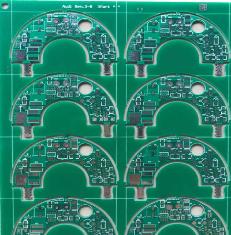Talking about the laser processing of ceramic circuit board
one. The principle of laser processing:
Laser processing uses the energy of light to achieve a high energy density at the focal point after being focused by a lens, and is processed by photothermal effect. Laser processing does not require tools, the processing speed is fast, the surface deformation is small, and various materials can be processed. The laser beam is used to perform various processing on the material, such as drilling, cutting, scribing, welding, heat treatment, etc. Certain substances with metastable energy levels will absorb light energy under the excitation of external photons, making the number of atoms at high energy levels greater than the number of atoms at low energy levels-the number of particles is reversed. If a beam of light is irradiated, the energy of the photon Equal to the corresponding difference between these two energies, then stimulated radiation will be generated and a large amount of light energy will be output.
two. Features of laser processing:
1. The laser power density is large, and the temperature of the workpiece rises rapidly after absorbing the laser and melts or vaporizes. Even the materials with high melting point, high hardness and brittleness (such as ceramics, diamond, etc.) can be processed by laser;
2. The laser head is not in contact with the workpiece, and there is no problem of processing tool wear;

3. The workpiece is not stressed and not easily polluted;
4. It can process the moving workpiece or the material sealed in the glass shell;
5. The divergence angle of the laser beam can be less than 1 milliarc, the spot diameter can be as small as micrometers, and the action time can be as short as nanoseconds and picoseconds. At the same time, the continuous output power of high-power lasers can reach kilowatts to ten kilowatts. Grade, so the laser is not only suitable for precision micro processing, but also suitable for large-scale material processing;
6. The laser beam is easy to control, easy to combine with precision machinery, precision measurement technology and electronic computers to achieve a high degree of automation and high processing accuracy;
7. In harsh environments or places where other people are inaccessible, robots can be used for laser processing.
3. Advantages of laser processing:
Laser processing is a non-contact processing, and the energy of the high-energy laser beam and its moving speed are adjustable, so a variety of processing purposes can be achieved. It can process a variety of metals and non-metals, especially materials with high hardness, high brittleness and high melting point. Laser processing flexibility is mainly used for cutting, surface treatment, welding, marking and punching. Laser surface treatment includes laser phase change hardening, laser cladding, laser surface alloying, and laser surface melting. Mainly have the following unique advantages:
1. Using laser processing, high production efficiency, reliable quality and economic benefits.
2. A variety of processing can be performed on the workpiece in the closed container through transparent media; in harsh environments or places where other people are inaccessible, robots can be used for laser processing.
3. There is no "tool" wear during laser processing, and no "cutting force" acts on the workpiece.
4. It can process a variety of metals and non-metals, especially materials with high hardness, high brittleness and high melting point.
5. The laser beam is easy to guide and focus to realize the transformation of various directions, and it is very easy to cooperate with the numerical control system to process complex workpieces, so it is an extremely flexible processing method.
6. Non-contact processing, no direct impact on the workpiece, so there is no mechanical deformation, and the energy of the high-energy laser beam and its moving speed are adjustable, so a variety of processing purposes can be achieved.
7. In the laser processing process, the laser beam has high energy density, fast processing speed, and local processing, which has no or minimal impact on the non-laser irradiated parts. Therefore, its heat-affected zone is small, the thermal deformation of the workpiece is small, and the subsequent processing volume is small .
8. The divergence angle of the laser beam can be less than 1 milliarc, the spot diameter can be as small as micrometers, and the action time can be as short as nanoseconds and picoseconds. At the same time, the continuous output power of high-power lasers can reach the order of kilowatts to 10kW. Therefore, the laser is not only suitable for precision micro processing, but also suitable for large-scale material processing. The laser beam is easy to control, easy to combine with precision machinery, precision measurement technology and electronic computers to achieve a high degree of automation and high processing accuracy.
Four. The actual situation of the current production of ceramic plates:
1. Punching, the conventional laser machine can reach more than 10 micro-holes per second, and the special laser machine can reach more than 100 micro-holes, and the efficiency is still very impressive.
2. Scribing, scribing is relatively simpler than punching, and the efficiency is faster. At present, 1PNL can be completed in about 30 seconds for conventional outer frames; the main purpose is to prevent missed jumpers and cut deviations.
Ceramic PCB laser processing technology has been widely used in many fields. With the continuous advancement of laser processing technology, equipment and process research, it will have a broader application prospect. Since the heat input to the workpiece during the ceramic PCB processing is small, the heat-affected zone and thermal deformation are small; the processing efficiency is high, and it is easy to realize automation. It can be seen that today's ceramic substrate cutting technology has achieved far-reaching development.